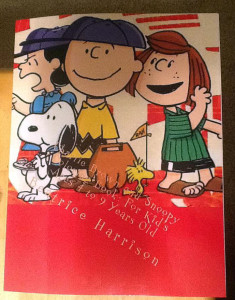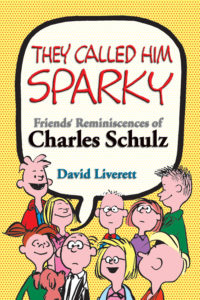Trading on Charlie Brown’s good name
- By : Nat
- Category : New releases, Reviews
Some folks talk about trademark as a way big, evil corporations “steal language” to keep the little guy from getting ahead. Actually, trademark legally exists to protect the little guy, the consumer, by letting them know that an item that bears a trademark meets the standards of the company that produced or licensed the product… and it becomes in the trademark holder’s interest to make sure that only good materials bear that trademark, to make sure the trademark is of value.
As an example, I give you the unlicensed Charlie Brown and Snoopy print-on-demand coloring book I found on Amazon the other day. (ADDED LATER: This blog posting went up on December 2. By December 5, the book had been removed from Amazon.) Normally, I would have been reluctant to purchase a new unlicensed item like this, but I know the turn-around time on print-on-demand product sold through Amazon, and I felt confident that this trademark-and-copyright violation would be cracked down on before the “author” of this work got paid. (After all, the same “author”, Mrs. Beatrice Harrison, has launched dozens of unlicensed coloring books and storybooks in the past couple months, largely Disney-owned properties like the princesses, Mickey, Star Wars and Spider-Man, but also Garfield, Superman, and others.) So let’s have a look at this little gem, shall we?
The front cover:
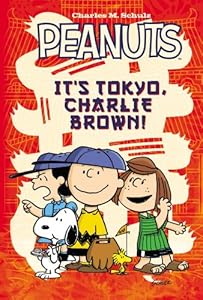 Hmmm… the top half is the cover of the recent graphic novel It’s Tokyo, Charlie Brown, cropped to remove both the title and most of the Schulz signature at the bottom. And this isn’t even some nice scan done from a printed copy of the book; it’s pixelated and has blatant jpeg artifacts, so it’s clear that the author just downloaded a cover shot from the web.
Hmmm… the top half is the cover of the recent graphic novel It’s Tokyo, Charlie Brown, cropped to remove both the title and most of the Schulz signature at the bottom. And this isn’t even some nice scan done from a printed copy of the book; it’s pixelated and has blatant jpeg artifacts, so it’s clear that the author just downloaded a cover shot from the web.
Then there is the title information, which is in a low-contrast color and is for some reason tilted partially over the image so that much of it is hard to read. (Could the “author” have done this solely to make sure that part of her name is on the image, so that no one else could easily rip off “her” book? Perhaps.)
And what is that cover text?
Charlie Brown and Snoopy
Coloring Book: For Kid’s
Ages 4 to 9 Years Old
Beatrice Harrison
Yes, yes, all you apostrophe police are cringing appropriately out there.
The interior:
The title page of the book repeats the same information, the same apostrophe, and gives us a one sentence “Biography” of the writer (we’ll get to that later). It doesn’t have such things as a copyright notice or trademark statement, of course, because that would slow the customer from getting to the heart of the coloring book: the coloring pages. Here’s one:
Note that the book is turned sideways to take this picture; some of the pages are sideways, some are normal. Now, that curvature you see in the picture is my fault, from photographing a book that doesn’t lay flat (which, by the way, is a bad thing in a coloring book), but that stretched-out look that Charlie Brown’s head has? Not my fault. Most of the pictures in the book are badly out of proper aspect ratio, making the characters look squished or stretched. They also show clear pixels and jpeg artifacts (i.e.: noisy gray areas around the lines.)
In the lower right corner of this and every image in the book is a URL. It points to a website that provides unlicensed downloads of images for coloring (I’ve blotted out part of the URL because I don’t feel like advertising such a site). That’s right, this book is just made up of images downloaded from that site, and the only reason why there are only 43 images in this book is that website has exactly 43 Peanuts images on it.
The back cover:
The back cover explains the book once again:
A fun and humorous cartoon that chil-
dren always loved “Charlie Brown
and Snoopy” the two funniest car-
toon characters on television. Coloring
book is for kid’s ages 4 to 9 years old.
The grammarless opening sentence! The hyphenation! The return of the inappropriate apostrophe! It’s almost like there wasn’t a team of editors and book designers assuring proper production, nor a licensor verifying the quality of the material!
And then we get a repeat of the biography from the first page of the book:
Beatrice Harrison enjoys writing chil-
dren books, traveling, and church.
“Children books” it does indeed say.
Now, Mrs. Beatrice Harrison does appear to indeed be an author. If you dig through the past couple months of her publication of unlicensed material, you will eventually find Sweethearts: A Romantic Suspense Novel, by Beatrice Harrison and Rodney Harrison. Go ahead, click the Amazon “Look Inside” link and read the deathless prose. You will see the same quality of effort put into Mrs. Harrison’s original material as in to her unlicensed material. You will also see double-spaced lines, a large font, and big margins… all those tricks you used in grade school to turn in that “five page” paper the teacher asked for they are using to turn a short story into a 116 page book.
Fighting the power:
Some people say that intellectual property laws simply drive up the cost of content, that if people were more free to reuse material without paying for it, prices would come down. Perhaps that can be argued, but boy, this would not be an exhibit in that argument. This 48 page coloring book (three are blank, one has printing information, one title page, and 43 pages of art) carries a list price of $5.95, although at the moment Amazon has it discounted to $5.36. I don’t know if you’ve shopped for coloring books lately, but you can get thicker ones than this at the dollar store. $5.95 would be considered a huge price even for a much thicker book.
And let me note that the thinness of the book speaks more to laziness in seeking out material than to greed in maximizing profits. As someone who uses the same print-on-demand service to publish books (Amazon’s subsidiary CreateSpace), I can tell you that she would make the same profit per copy sold if it was a 100 page book at that price. (In case you’re wondering, that’s $1.42 per copy sold through Amazon, which is presumably the bulk of her sales.)
Meanwhile, she has racked up 10 reviews of her licensed material: one five-star review that appears to be from a kid praising the property being licensed, rather than the book; one two-star review, and eight one-star reviews (the worst Amazon allows.)
So if you ever wanted to find a book that you should avoid for both moral and asthetic reasons, here you go!
By the way:
If the words “color” and “book” go together well in your mind, I’ve got two fairly new all-in-color books to steer you toward during this most shoppingest of seasons:
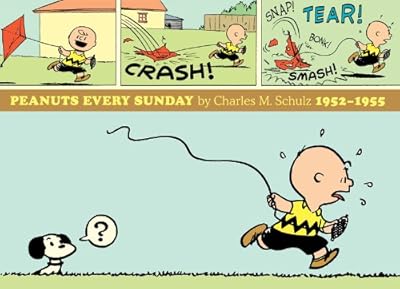 Peanuts Every Sunday: 1952-1955. Years of big, pretty Peanuts Sunday strips.
Peanuts Every Sunday: 1952-1955. Years of big, pretty Peanuts Sunday strips.
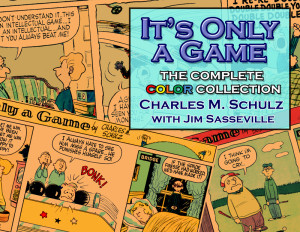 This one is published by me – its a color collection of the complete run of Schulz’s other syndicated newspaper feature, It’s Only a Game.
This one is published by me – its a color collection of the complete run of Schulz’s other syndicated newspaper feature, It’s Only a Game.
